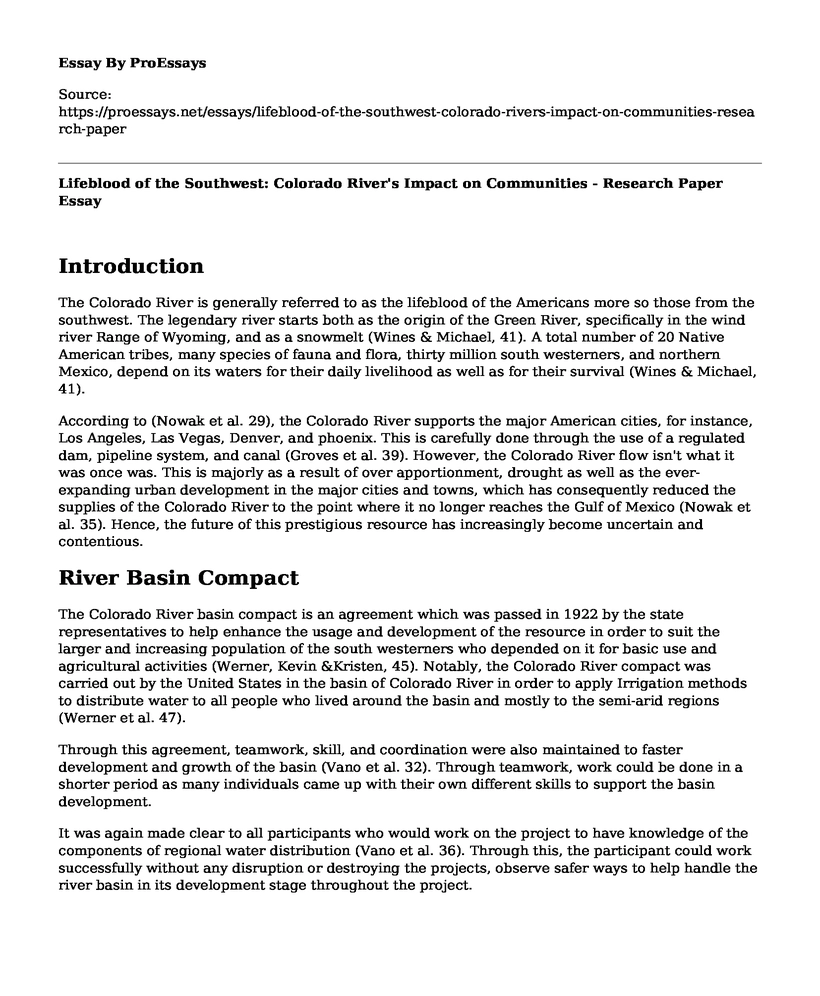Introduction
The Colorado River is generally referred to as the lifeblood of the Americans more so those from the southwest. The legendary river starts both as the origin of the Green River, specifically in the wind river Range of Wyoming, and as a snowmelt (Wines & Michael, 41). A total number of 20 Native American tribes, many species of fauna and flora, thirty million south westerners, and northern Mexico, depend on its waters for their daily livelihood as well as for their survival (Wines & Michael, 41).
According to (Nowak et al. 29), the Colorado River supports the major American cities, for instance, Los Angeles, Las Vegas, Denver, and phoenix. This is carefully done through the use of a regulated dam, pipeline system, and canal (Groves et al. 39). However, the Colorado River flow isn't what it was once was. This is majorly as a result of over apportionment, drought as well as the ever-expanding urban development in the major cities and towns, which has consequently reduced the supplies of the Colorado River to the point where it no longer reaches the Gulf of Mexico (Nowak et al. 35). Hence, the future of this prestigious resource has increasingly become uncertain and contentious.
River Basin Compact
The Colorado River basin compact is an agreement which was passed in 1922 by the state representatives to help enhance the usage and development of the resource in order to suit the larger and increasing population of the south westerners who depended on it for basic use and agricultural activities (Werner, Kevin &Kristen, 45). Notably, the Colorado River compact was carried out by the United States in the basin of Colorado River in order to apply Irrigation methods to distribute water to all people who lived around the basin and mostly to the semi-arid regions (Werner et al. 47).
Through this agreement, teamwork, skill, and coordination were also maintained to faster development and growth of the basin (Vano et al. 32). Through teamwork, work could be done in a shorter period as many individuals came up with their own different skills to support the basin development.
It was again made clear to all participants who would work on the project to have knowledge of the components of regional water distribution (Vano et al. 36). Through this, the participant could work successfully without any disruption or destroying the projects, observe safer ways to help handle the river basin in its development stage throughout the project.
Federal, State or Regional Legislature That Was Created for the Regulation of the Water Sources
The Colorado river basin is guided by a number of courts decisions, decrees, laws, and rights that are commonly known as the "Law of the River" as discussed below;
The Colorado River basin project act; it's an authorized construction of several water development projects in both the basins; thus, it made it easier in the distribution of water to different regions, including the semi-arid areas (Werner et al. 51). Through this act, the larger population in the States could easily get water for both agriculture and other home use.
The building of dams and reservoirs [the storage act]: This was done to help the bigger population get enough water. The storage dams helped in storing enough water for the larger population in that the stored water could be useful in other fields and also could be used up mostly for the agricultural basis in semi-arid areas as the food was mostly obtained from crops grown through irrigation (Castle et al. 45).
River basin compact: It was an agreement made up by the state representatives on how they could develop and help maintain the water sources, which was mainly Colorado River (Castle et al. 53). Thus, through this agreement, it was passed through as an act that led to creation as well as the regulation of water sources. Through this act, there was water distribution, development of River Colorado Basin, which afterward was maintained by the skilled participants who worked on it and successfully completed it (Castle et al. 55).
Works Cited
Castle, Stephanie L., et al. "Groundwater depletion during drought threatens future water security of the Colorado River Basin." Geophysical Research Letters 41.16 (2014): 5904-5911.
Groves, David G., et al. Adapting to a Changing Colorado River: Making future water deliveries more reliable through robust management strategies. RAND Corporation, 2013.
Nowak, Kenneth, et al. "Colorado River basin hydroclimatic variability." Journal of Climate 25.12 (2012): 4389-4403.
Vano, Julie A., et al. "Understanding uncertainties in future Colorado River streamflow." Bulletin of the American Meteorological Society 95.1 (2014): 59-78.
Werner, Kevin, and Kristen Yeager. "Challenges in forecasting the 2011 runoff season in the Colorado basin." Journal of Hydrometeorology 14.4 (2013): 1364-1371.
Wines, Michael. "Colorado River Drought forces a painful reckoning for states." New York Times 5.01 (2014).
Cite this page
Lifeblood of the Southwest: Colorado River's Impact on Communities - Research Paper. (2023, Mar 30). Retrieved from https://proessays.net/essays/lifeblood-of-the-southwest-colorado-rivers-impact-on-communities-research-paper
If you are the original author of this essay and no longer wish to have it published on the ProEssays website, please click below to request its removal:
- Sociology Essay Example - Gender Stereotypes and Culture
- Homeless Bill in Hawaii Essay
- Essay Sample on Single Parenting and Dual Parenting
- Daniel Boone: Offender, Prisoner, HIV-Infected Pedophile - Case Study
- Addressing Childhood Obesity in Alabama: A Growing Concern - Research Paper
- Opium: From Ancient Empires to Latin America and Afghanistan - Research Paper
- Essay Example on Seasons: Changing Habits, Climate & Lives







